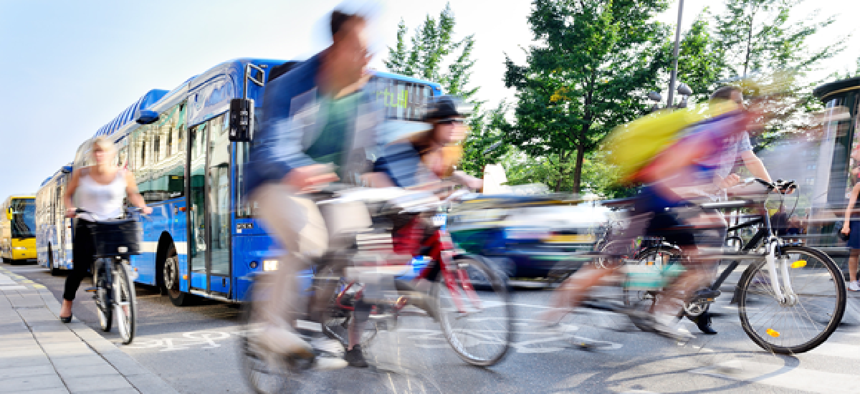How cities use data to plan bike routes

An increasing number of cities are using data from video cameras and crowdsourced apps to track and plan the best way for bicyclists to get around.
City workers with clipboards, pencils and a long day ahead of them used to be how communities identified popular bicycle routes. But an increasing number of cities are using data from video cameras and crowdsourced apps to track and plan the best way for bicyclists to get around.
Video that avoids the Big Brother label
Placemeter -- a video tracking system that analyzes existing video feeds and applies computer vision algorithms to them to count cars, pedestrians and bicycles -- is doing its best to track traffic and still appease those who might be a little camera shy by only recording shapes, not faces.
After Placemeter’s launch in 2011, the company was alerted to possible privacy issues with its continuous live video feed, Marketing Director Melissa Sanchot said. “A lot of people were saying, ‘Wait, you are using video feed. People can be identified.’ Now our computers only store shapes so we know what kind of traffic is moving in an area.”
The system protects privacy by recognizing only shapes (humans, bikes, trucks, cars and even dogs) and not storing the video. “It can’t even be used for security reasons because we don’t have it,” Sanchot said.
Beyond quantity, Placemeter also measures each shape’s trajectory to help cities learn where bicyclists are going, what they are doing, where are they making turns and their speed, Sanchot said. This helps city councils, like the ones Placemeter is working with in Philadelphia, Boston, and Washington, D.C., decide how much of a budget needs to be set aside for bike routes, and where the investments should be concentrated.
In New York City, Placemeter is helping officials understand pedestrian traffic, primarily to help those interested in opening small businesses determine the most promising location.
The city understood the importance of quantifying its bike traffic. “If you don’t know the number of bikes, then you can’t justify the budget for what you need to put in bike lanes,” Sanchot said. Armed with data about current bike traffic, officials can better estimate what they need.
The company partnered with Cisco on project in Paris to rethink the space for bikes, cars and pedestrians in an underutilized plaza. To make sure all Parisians can stay involved, two touchscreens have been set up in the plaza to share all the data in real time.
Sanchot also said Placemeter is not wedded to working with big cities, and makes a point of being affordable enough for small locales. “We work in Brooklyn in a city improvement district, and they are pretty much a nonprofit,” she said. “We can find solutions for those even with a small budget.”
Bike routes based on the popular vote
Strava Metro is another company helping cities rethink the way they plan bicycle routes via crowdsourced data. Using the data from Strava Metro’s network of app users who log their commuter and/or recreational routes, cities are able to see when and where cyclists are moving throughout the city.
“Metro data enables deep analysis of cyclist and pedestrian activity including popular or avoided routes, peak commute times, intersection wait times and origin/destination zones. Metro processes this data for compatibility with geographic information system (GIS) environments,” Brian Devaney, the company’s marketing lead, said.
To address privacy concerns for individuals in the more than 75 cities with which the company works, Strava Metro does not identify users as part of its data, and it allows users to opt out of providing data or to blur their start and end points so that specific whereabouts can’t be identified. The personal information never makes it to the cities that contract with the company.
“Metro fully anonymizes and aggregates this data and then partners with departments of transportation and city planning groups to improve infrastructure for bicyclists and pedestrians,” Devaney said.
Why the fuss over improved city bike routes?
Cities are realizing that improved access for cyclists actually improves traffic congestion, according to Ken McLeod from the Bike League of America. “If you give bikes safe places to go, you can control where bicyclists are and where bike/motorists conflicts are. And people can get around the community with the fewest possible conflicts.”
Another reason cities are interested in promoting bike routes is that it helps local economies to have people biking rather than driving by a store, McLeod said. “It costs less to bike, and so people have more disposable income to spend in the community," he explained. "Stores near bike routes have increased customer traffic.”
And while the technology has dramatically improved the planning process, McLeod said, what it can’t do yet is identify those that want to bike but don’t -- those he calls “interested but concerned groups.” That demographic includes people who would bike to work if they could avoid a certain stressful intersection, or the AAA group (all ages and abilities), such as families with kids who aren’t sure where to go or how to get started, he said.
NEXT STORY: DC hires its first chief data officer





